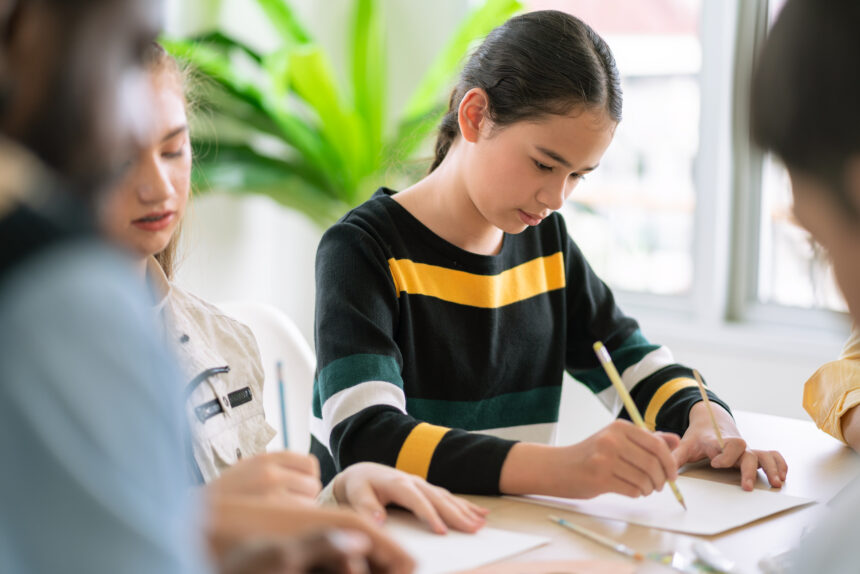We’ve all had instances when we’re so focused and absorbed in an activity that time seems to disappear. It’s in this space – referred to as a ‘flow state’ – that we can find our highest levels of creativity and productivity. So, what is flow, how can your child become familiar with their own flow state, and what benefits can they gain from operating within this state?
Flow is the mental space where thoughts and ideas move without interruptions or doubts. It’s an ideal performance state where individuals experience exceptional focus and creativity; time distorts, permitting children to accomplish tasks in significantly less time. To access this mystical realm, children must become self-aware of their triggers for entering into a flow state, and you, as a parent, can guide them in making conscious choices about how to utilise them to enhance their productivity.
By recognising the signals and cues indicating they are in a state of flow, such as heightened motivation, clear thinking and increased creativity, your child can learn to consciously nurture this state more frequently. This can be achieved through mindfulness practices like meditation or journaling, or activities such as physical exercise, music appreciation or exploring the outdoors. By doing so, they can unlock the vast reaches of their creative potential.
The benefits of being in a flow state are extensive; research suggests it leads to better quality work, higher attention to detail, increased problem-solving capability, sustained focus and greater task satisfaction. Moreover, other studies have discovered that operating from a flow state also reduces stress while saving time – making it an incredibly valuable tool for creating truly meaningful work.
Understanding creative and numerical-driven flow states
The concept of flow, or being “in the zone”, has been explored for decades by psychologists aiming to uncover the secrets of optimum performance. Flow is defined as a mental state where an individual becomes completely absorbed in their task, experiencing a state of total focus, energy and enthusiasm. It’s often said that when one is fully in flow, they are producing their best work. Although there are various types of flow states, two main categories can be identified: creative flows and numerical flows.
Creative flows are typically associated with extroverted personalities and involve activities such as writing stories or creating art. These types of flow require lateral thinking and brainstorming techniques for generating new ideas. Furthermore, creative flows rely on attention to detail and tend to involve emotions more than other types of flows. Children who excel at creative flows usually enjoy sharing their ideas with others and thrive on collaboration.
Numerical flows refer to tasks involving numbers or mathematical equations; these tasks may include coding software or making complex calculations for a science project. Numerical flows are commonly linked with introverted personalities because they require a child to focus on details without being distracted by external input. Children who excel at numerical flows generally find comfort in working independently while applying problem-solving skills within a structured process.
The differences between these two types of flow have been extensively studied, but it’s clear that both can result in peak performance if given the right conditions. What works for one child may not work for another; however, understanding the characteristics associated with each type of flow can help children identify which one suits them best. Once determined, children can use tools such as mindfulness practices and goal setting techniques to achieve a flow state more readily and improve their productivity levels overall.
Helping your child unlock the benefits of being in flow
For many children, procrastination is a way of life, full of constant distractions and barriers to productivity. However, the truth is that every child has the capacity to unlock their maximum potential and take control of their tasks. Being in flow – defined as “the state in which your skill level and challenge level are well-matched” – can provide a sense of clarity, focus and deep engagement with an activity or task at hand.
When a child is in flow, they experience intense concentration on the task and a loss of awareness towards any other external stimuli; this often results in higher levels of creativity, innovation and productivity. Flow allows them to unlock their true potential for success by reaching higher performance levels than previously thought possible.
Achieving flow is no easy task; it requires practice and consistency. To begin the journey into flow, children must first identify what tasks will bring them the most enjoyment and satisfaction. Once these activities are identified, they should be pursued regularly until the child finds themselves fully engaged without distraction or interruption. This could involve establishing routines such as creating a dedicated workspace or setting aside specific times each day to engage in their chosen activity without interruption.
What happens when children don’t reach flow?
Reaching a flow state requires dedication, focus and the right environment, but if children don’t reach that level of immersion, there can be serious consequences. Not taking the time to ease into a flow state can lead to exhaustion, frustration and a lack of productivity.
When attempting to transition into a flow state, it helps to prepare with intentionality.
Flow states are most easily reached when a child is in an environment suited for creative thinking such as playing outdoors or in their favourite room at home. Taking time to breathe deeply and focus on the task ahead will help create an atmosphere conducive to reaching a flow state. It’s important to understand what triggers are necessary for your child to become fully immersed in whatever task they are undertaking. This could include specific music, lighting or even temperature needs that allow them to create an environment that encourages getting “in the zone” quickly and efficiently.
If not done correctly, trying too hard to reach a flow state can lead to becoming easily distracted or developing feelings of anxiety due to overthinking the approach. Many children underestimate the importance of preparing for the deep focus needed for reaching the peak performance levels associated with being in a flow state, which can leave them feeling overwhelmed and discouraged from further attempts at achieving this type of productive output.
It isn’t enough just to want something; sometimes being ready for it involves putting oneself in the proper mindset by creating conditions optimal for success. If done correctly, transitioning into a flow state can provide clarity on how best to complete tasks without feeling overwhelmed or bogged down by details that could sidetrack progress. To ensure your child is setting themselves up for success each time they attempt to reach this mindset, ensure proper preparation has been made beforehand so they can maximise their productivity when working towards their goals.
Guiding your child to discover their flow triggers – identifying activities & achieving focus
Helping your child find their personal triggers for achieving flow involves recognising which activities help them best reach a level of focus and concentration where time seems to fly. It’s an optimal state of productivity, creativity, and enjoyment – one that many strive for yet don’t quite know how to reach. The good news is that by identifying their personal triggers, children can develop strategies to help them enter the ‘Flow Zone’ more frequently!
Take some time to reflect with your child on what puts them in this desired state. For some, it might be physical activity like football or gymnastics, while others may find that reading a certain type of book or listening to instrumental music helps them reach this peak level of performance. There are no strict rules here – every child will have different activities or environments that work for them.
Once you and your child recognise their unique triggers for getting into flow, start incorporating these activities into their daily routine. Allocate time each day for an activity that puts them in this productive state – take a walk around the neighbourhood or try meditating before starting homework tasks. Ensuring they have this time to themselves can make all the difference, and can help them bring this optimal state of focus and engagement into other areas of their life.
Final thoughts
Helping children enter their flow state regularly has manifold benefits. Not only does it help them tap into their creative side and enhance their productivity, but it also boosts their self-confidence and promotes emotional well-being. Operating in a flow state helps them manage stress more effectively, as they focus completely on the task at hand and aren’t distracted by external stressors. The skills that children learn from this practice will not only help them perform better academically, but also equip them with the tools to be more resilient and adaptable in the future.
Above all, flow is about enjoying what we do. We often perform best when we are doing something we love and are passionate about. By helping your child identify their flow triggers and guiding them to embrace their flow state, you’re helping them recognise their passions and strengths. This understanding can guide them in their future career choices, helping them to choose a path that they genuinely enjoy and are naturally inclined towards.
So, encourage your child to embrace the flow. Help them identify their triggers, create a conducive environment, and give them the space they need to explore this unique state of consciousness. The experience and benefits they gain from this practice will serve them well in the future. Flow is not just about improving performance or productivity; it’s about the joy of being completely immersed in what we love. And who wouldn’t want to cultivate more of that in their child’s life?

The Abundance Mentor


Leave a Reply